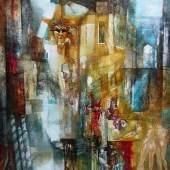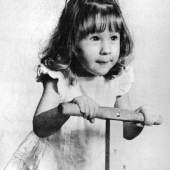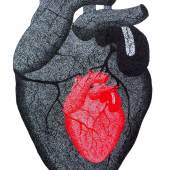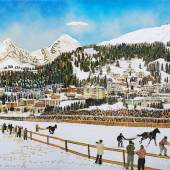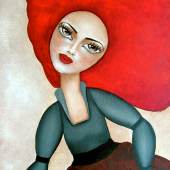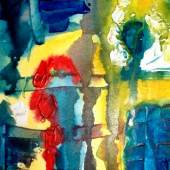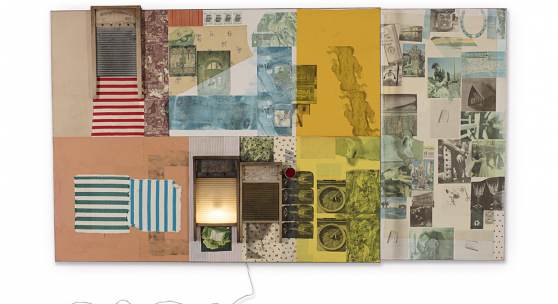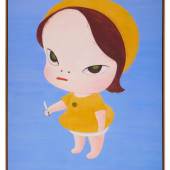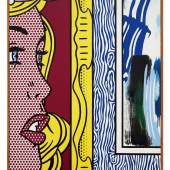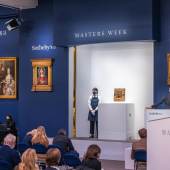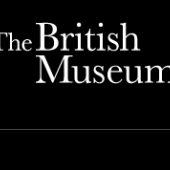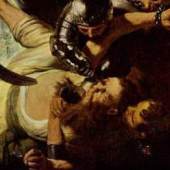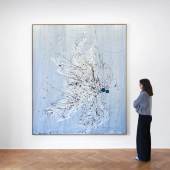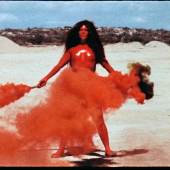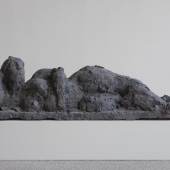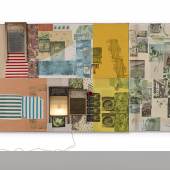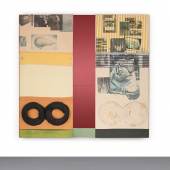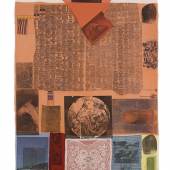Robert Rauschenberg's 'Autobiographical' Spreads (1975-83)
-
Ausstellung29.11.2018 - 09.02.2019
Galerie Thaddaeus Ropac London, together with the Robert Rauschenberg Foundation, presents the first UK exhibition dedicated to the American artist’s remarkable Spreads, a series that occupies an important position in his oeuvre. The large-scale Spreads (1975–83) encapsulate many of Robert Rauschenberg’s best-known motifs and materials. Twelve key works from the series―the largest of which stretches to over six metres wide―will go on view at Ropac’s London gallery from 28 November 2018. An integral series of paper collages from the same period will also be exhibited, incorporating fabrics and techniques that relate to the Spreads series.
“They are more like ideas than objects―reels of association run through the projector of a mind unusually sensitive to the up-and-down jangles of modern life.” Thomas B. Hess
One of the most influential artists of the post-war period, Rauschenberg revolutionised the picture plane with his hybrid painting-sculptures, created through the innovative inclusion of everyday objects―what he called “gifts from the street”. These Combines (1954–64) marked a watershed moment in the history of post-war art, redefining and expanding the boundaries of what could be considered an artwork. It was in 1976, as the artist prepared for an important mid-career retrospective, that Rauschenberg found inspiration for his new Spreads series. The exhibition, which opened at the National Collection of Fine Arts (now Smithsonian American Art Museum) in Washington, D.C., offered Rauschenberg the opportunity to revisit works he had not seen for up to 25 years, prompting what he described as “autobiographical feelings”, and imparting a retrospective aspect to his new works.
In these Spreads, “classic Rauschenberg” motifs from his object-laden Combines resurfaced, including tyres, doors, bedding, ironing boards, mirrors, electric lights, ventilators, metal traps, images of exotic animals, bird wings, umbrellas and parachutes that recalled those in his acclaimed 1963 performance piece Pelican. Yet these fulcrum works were also informed by the materials and images of his silken Jammers (1975–76) and solvent transfer Hoarfrosts (1974–76), whilst prefiguring his later metal works from the 1980s–90s, such as the Shiners (1986–93), Urban Bourbons (1988–96) and Borealis (1988–92).
“Rauschenberg is a painter of history―the history of now rather than then” John Richardson
Rather than a purely retrospective exercise, the development of his Spreads is also suggestive of a more complex relationship between past and present, integrating not only elements from his earlier work but also reflecting changes in his life, his practice and in contemporary art at the time. Rauschenberg’s use of fabric colour blocks in his Spreads not only represented a shift in his colour palette from the urban experience of New York to the bright oranges, pinks and yellows of life in Florida, but also engaged with recent artistic developments such as Colour Field painting and Minimalism, incorporating references to a new generation of artists.
-
18.11.2021Sotheby’s To Announce Live Bidding Increments in Ether (ETH) Cryptocurrency For Banksy...
-
15.11.2021 - 19.11.2021Sotheby’s Lifts the Curtain onOne of the Most Important Sales Series Ever Staged $1 BILLION...
-
28.01.2022Sotheby’s New York Master Paintings and Sculpture Part ITotals $91 MillionSecond Highest...
-
Museum Boymans-van Beuningen, Rotterdam Rembrandt Werke "Allegorie auf die Eintracht des...
-
18.05.2024 - 20.07.2025Created in the artist’s studio north of Salzburg, this new series of paintings and ink...
-
21.09.2024 - 25.01.2025Group exhibition Carl Andre Joan Brown Rosemarie Castoro John Chamberlain Judy Chicago Dan Flavin...
-
28.11.2024 - 05.02.2025Marking Joan Snyder’s first solo exhibition with the gallery, Body & Soul is...
-
21.12.2024 - 01.03.2025Diese Ausstellung präsentiert eine Auswahl von Skulpturen Hans Josephsohns (1920–2012), die...
-
29.11.2018 - 09.02.2019
GALERIE THADDAEUS ROPAC
37 DOVER STREET, LONDON W1S 4NJ T +44 (0) 20 3813 8400 ROPAC.NET
OPENING HOURS TUESDAY – SATURDAY 10 AM – 6 PM
